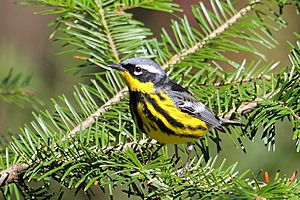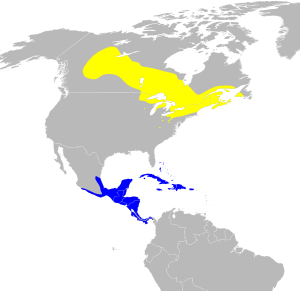Magnolia warbler facts for kids
Quick facts for kids Magnolia warbler |
|
|---|---|
 |
|
| An adult male in Quebec | |
| Conservation status | |
| Scientific classification | |
 |
|
| Range of the S. magnolia Breeding range Wintering range | |
| Synonyms | |
|
Dendroica magnolia |
The magnolia warbler (Setophaga magnolia) is a small, colorful songbird. It belongs to the wood warbler family, called Parulidae. These birds are known for their bright yellow, black, and white feathers. They are a common sight in forests across North America.
Contents
What's in a Name?
The first part of the bird's scientific name, Setophaga, comes from Ancient Greek words. Ses means "moth" and phagos means "eating." So, it means "moth-eating."
The second part of its name, magnolia, comes from where it was first found. An American bird expert, Alexander Wilson, discovered this bird in magnolia trees. This was near Fort Adams, Mississippi in 1811.
Meet the Magnolia Warbler
The magnolia warbler is a moderately small bird. It is about 11 to 13 cm (4.3 to 5.1 in) long. Its wings can spread 16 to 20 cm (6.3 to 7.9 in) wide. An adult bird usually weighs between 6.6 to 12.6 g (0.23 to 0.44 oz).
You can tell a magnolia warbler by its colors.
- Breeding males have white, gray, and black on their backs. Their sides are yellow. Their stomachs are yellow with black stripes. They have white patches on their wings, called wing bars. Their tails are black with white stripes underneath.
- Breeding females look similar to males. However, their colors are much duller.
- Young warblers also have the duller colors of the females.
The yellow and black-striped stomach helps tell them apart from similar birds. For example, the prairie warbler and Kirtland's warbler look a bit alike.
Where Do They Live?
Magnolia warblers live in the northern parts of North America. You can find them in parts of the Midwestern United States. This includes states like Minnesota and Wisconsin. They are mostly found across northern Canada. This includes areas like Saskatchewan, Manitoba, Ontario, and Quebec.
During the winter, these birds fly south. They migrate through the eastern United States. They travel all the way to southern Mexico and Central America. They also go to parts of the Caribbean.
Magnolia warblers like to breed in dense forests. They prefer young, tightly packed evergreen trees. During migration, they can be found in many different types of woodlands.
Life Cycle of the Magnolia Warbler
Magnolia warblers change their feathers several times. This process is called molting. The first molts happen when the young birds are still in the nest. Other molts happen near their breeding grounds.
After molting, they breed and care for their young. Then, they migrate.
- Eggs hatch after about two weeks.
- Chicks can leave the nest after nearly another two weeks. This is when their feathers are more developed.
- After about a month, the young birds can live on their own. They are solitary birds.
- Magnolia warblers usually live up to seven years.
Behavior
What Do They Eat?
Magnolia warblers mainly eat arthropods. Their favorite food is caterpillars. They also eat different types of beetles, butterflies, and spiders. During breeding season, they eat fruit too. In winter, they eat more fruit and nectar. These birds also sometimes eat parts of evergreen tree branches. They prefer trees like spruce firs in their breeding areas.
Warbler Songs
Male magnolia warblers have two different types of songs. These are called First Category and Second Category songs. Female warblers also sing, but they don't have different songs for different situations like the males do.
Male warblers use their songs during spring migration and breeding season. One song is for attracting a mate. The other song is used daily to mark their territory. Both males and females have short call notes. They use these for different alerts. Females use them to signal when a human is watching. Males use them to warn about predators near their young.
Reproduction
Male magnolia warblers arrive at their breeding grounds about two weeks before the females. Once the females arrive, both parents work together to build a nest. This takes about a week. It's hard to find their nests because they are hidden in dense forest. So, it's not known if they reuse old nests or build new ones each year.
Nests are built in evergreen trees. They prefer fir trees like balsam fir (Abies balsamea) and spruce fir (Picea glauca). The nest is small, shallow, and circular. It's made of grass, twigs, and horsehair fungus. Nests are usually found low to the ground, often within the first three meters of the tree.
Female magnolia warblers usually lay three to five eggs. The female waits until all eggs are laid before she starts sitting on them. She incubates the eggs for about two weeks until they hatch. The female also keeps the newborn chicks warm by sitting on the nest. She feeds the chicks most often. However, males also help feed the young. Males are monogamous, meaning they stay with one mate. They spend a lot of energy finding food for their young. To keep the nest clean, females eat the waste sacs of their newborns. As the chicks get older, both parents simply remove the waste from the nest. Baby warblers are ready to fly out of the nest when they are about ten days old.
Conservation
The magnolia warbler is listed as "least concern" for conservation. This means it is not at high risk of extinction. It is quite common and widespread in its habitat.
However, some things do affect them:
- Many warblers die by flying into tall structures during migration.
- Their forest habitats are sometimes cleared. This reduces the number of warblers in those specific areas.
Even though these issues exist, the species as a whole is not greatly impacted. This is because there are so many of them across the region.
In art
The famous artist John James Audubon drew the magnolia warbler. It was featured in his book The Birds of America, published between 1827 and 1838. His drawing, Plate 123, was titled "Black & Yellow Warbler – Sylvia maculosa." It shows a pair of birds, a male and a female, looking for insects on a flowering raspberry plant. The original artwork is now owned by the New York History Society.
See also
 In Spanish: Reinita de magnolia para niños
In Spanish: Reinita de magnolia para niños




